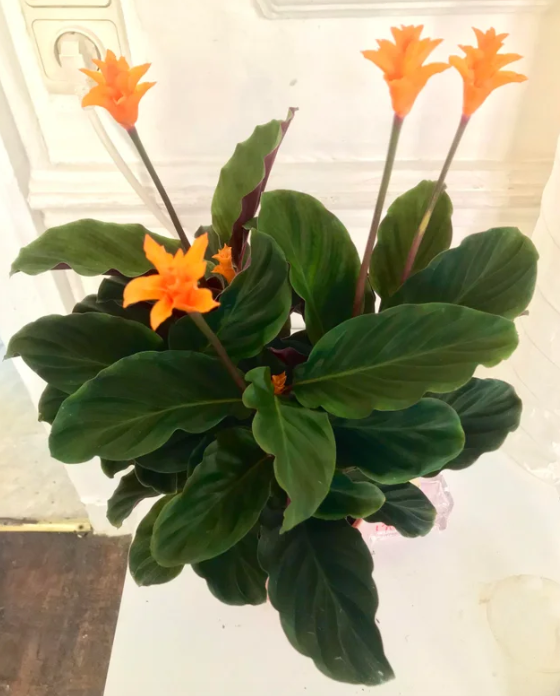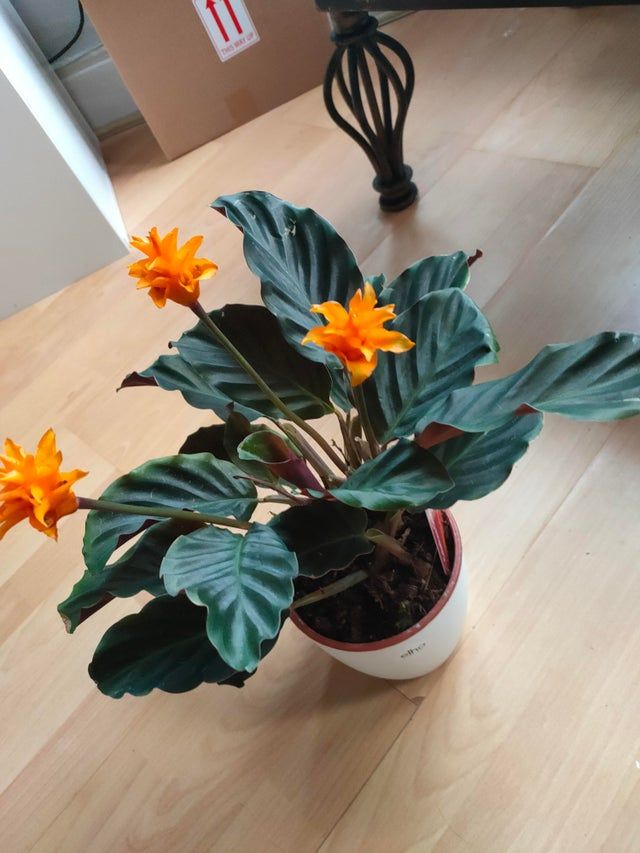Should I get a Calathea Crocata Plant? (Tassmania Bloom)

If you're like me, you love adding plants to your home to brighten things up and add life. But sometimes it's hard to know which plants are best for your environment and which ones will thrive in your care.
If you're interested in adding a Calathea Crocata plant to your indoor landscape, then read on for some information about this beautiful plant.
Before we start, remember that Calathea's are generally fussy plants!
As beautiful as Calathea can be, they do come with a little curse. They are notoriously unforgiving plants. If you make one mistake with them, they will punish you. Their leaves die with ease, and the internet is littered with messages from grieving calathea parents who's plant died because they looked away for a second.
So be careful what you wish for with any Calathea! While they may add a beautiful touch to your home, it is important to be aware of their finicky nature before making them a part of your family. With a little love and care, however, calatheas can make wonderful houseplants that will brighten up any space.
Where is the Calathea Crocata from?
Calathea crocata (also known as the Tassmania bloom plant or the Eternal flame plant because of it's bright leaves) is a beautiful evergreen perennial that originates from the tropical wet forests of Brazil (evergreen perennials are plants that do not shed their foliage during cold winter months).
The plant was relatively unknown until the 1970s, when it was introduced to Hawaii. Since then, it has become increasingly popular among plant enthusiasts, due to its non-toxic nature (which makes it safe for cats and other pets).
The plant has large, oval-shaped leaves that are dark green in color with purple or burgundy markings. Calathea 'Tassmania' has strongly ruffled leaves and grows more compactly than its other calathea cousins. In cold countries, Calathea crocata is usually cultivated as indoors because it is sensitive to frost.
From early spring until about mid-summer, you can enjoy the bright orange colors of this plant's flowers. It's called "Eternal Flame Plant" for good reason!

Where can I keep my Calathea crocata?
In order for Calathea crocata to thrive, it needs a warm and humid environment similar to that found in the tropics. This plant prefers indirect light with high humidity levels so you should place your tropical houseplant in a conservatory (if you have one) or a window that is not facing the direct sun.
Calathea crocata needs to stay warm in winter all year round. In winter, make sure the temperature does not drop below 20 degrees Celsius. In summer they should have a temperature range of 25 - 30°C (77ºF – 87º Fahrenheit).
If your Calathea crocata is outdoors during the summer, the location should be shady.
Avoid using hard water on your Calathea plant!
Have you ever noticed little white spots on the leaves of your Calathea tassmania plant? This is caused by hard water.
When water contains a high concentration of minerals like calcium and magnesium, it's considered hard water. And while this type of water is perfectly safe to drink, it can cause problems for plants. That's because the minerals can start to accumulate on the leaves, preventing the plant from absorbing the nutrients it needs. As a result, the plant may become yellow or brown and eventually die.
If you suspect that hard water is harming your plants, consider using a filter to remove the minerals before watering. This simple step can make a big difference in the health of your plants. Either way, it's a good idea to check the labels on your plants before you buy them to see if they're susceptible to hard water damage. That way, you can avoid any surprises down the road.
If you're noticing similar spots on your plant, research the water quality in your area and make the switch to filtered water if necessary!
What are the soil and feeding requirements for my Calathea crocata?
Calathea crocata likes to live in loose, well-drained soil with plenty of nutrients. April to September is the growing season for Calathea crocata, during which time it should be supplied with organic liquid fertilizer once a month.
Fertilizer sticks can also be used as a convenient way to provide the plant with the nutrients it needs. During the winter months, the fertilizer doses should be reduced or stopped altogether. This is because the Calathea goes into a dormant state and does not require as much food.
The best way for this plant's roots system to work optimally and avoid problems like root rot or fungus growth would be if you provide them good drainage at all times so they can easily remove excess fluids from their surface area before it causes damage!
By following these simple guidelines, you can ensure that your Calathea crocata stays healthy and blooms beautifully year after year.
When is the best time to propagate my Calathea crocata plant?
Spring is the perfect time to multiply your calathea by dividing them. You can carefully loosen the root ball with your fingers and divide it into pieces that arise naturally. In relatively warm temperatures, all potted cuts will develop well. Tassmania plants are easy to divide and don't require much care afterwards. With a little effort, you can have a beautiful Calathea garden in no time!

Common problems for the Calathea crocata
Calathea crocata is a beautiful plant that is often grown as a houseplant. However, they are also notorious for being finicky plants that require precise care. One of the most common problems Calatheas face is infestation from Red spider mites or aphids.
Spidermites are very small, red arachnids that feed on plant sap. They can cause leaves to turn yellow, brown or even black. If the infestation is severe, the plant may die.
Aphids are tiny, green or black insects that also suck sap from plants. They can cause leaves to curl and distorted growth. Aphids can also spread diseases to plants.
Red spider mites and aphids can spread quickly if the environment is not suitable, and too much sunlight can burn the leaves. Dry air can also cause the foliage of the plant to wither.
If you notice that your Calathea crocata has any of these pests, take action immediately! There are many ways to get rid of spidermites and aphids including using insecticidal soap, horticultural oil or neem oil. Be sure to read the instructions carefully so you don't damage your plant.
Another common problem for Calatheas is overwatering. This can cause the roots to rot, which will eventually kill the plant. Make sure to water your Calathea only when the soil feels dry to the touch and never allow it to sit in water.
With proper care, however, these problems can be avoided and Calathea crocata will thrive.
General advice from other Calathea crocata plant parents
Humidity is very important to this plant
One thing to keep in mind with calatheas is that they prefer high humidity, so expect brown spots on the flowers unless you keep them close by an humidifier.
If you don't have access to a humidifier, then misting them regularly is also a good idea.
Just be careful not to get water on the leaves, as this can cause brown spots and make the leaves wilt. To avoid this, you can just cover the flowers with small plastic cups while you mist.
How I removed Lime Deposits from my Calathea Plant
I started noticing these white spots on the velvet leaves of my Calathea crocata plant and I did some research to figure out what was causing it.
I realized that the water where I live is high in magnesium, which wasn't affecting us humans but was harming the calathea plant. I switched to using filtered water and I also used a vinegar solution to wipe my plants every day until the white spots disappeared totally.
Below are the exact steps I followed to get rid of the lime deposits on my beautiful Tassmania plant.
-
Simply mix equal parts vinegar and distilled or rainwater in a spray bottle and mist the leaves of the affected plant.
-
Use a soft cloth or sponge to gently dab the deposits. Allow the vinegar solution to sit for five to 10 minutes, but be sure not to let it dry on the leaves.
-
After 10mins, get another clean cloth, pour distilled water only and use to wipe off the vinegar solution on the plant.
If you are concerned about using Vinegar for your Calathea plant, do not worry. For many years, vinegar has been used as a natural cleaning agent. Its acidic nature helps to break down dirt and grime, making it an effective way to clean a variety of surfaces. Best of all, vinegar is gentle and non-toxic, making it safe to use around plants and pets alike.